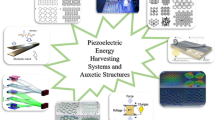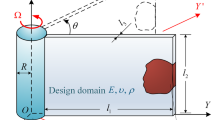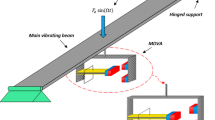Abstract
In this study, a passive suppression scheme for nonlinear flutter problem of composite panel, which is believed to be more reliable than the active control methods in practical operations, is proposed. This scheme utilizes a piezoelectric inductor-resistor series shunt circuit. The finite element equations of motion for an electromechanically coupled system is derived by applying the Hamilton’s principle. The aerodynamic theory adopted for the present study is based on the quasi-steady piston theory, and von-Karrnan nonlinear strain-displacement relation is also applied. The passive suppression results for nonlinear panel flutter are obtained in the time domain using the Newmark-β method. To achieve the best damping effect, optimal share and location of the piezoceramic (PZT) patches are determined by using genetic algorithms. The effects of passive suppression are investigated by employing in turn one shunt circuit and two independent shunt circuits. Feasibility studies show that two independent inductor-resistor shunt circuits suppresses flutter more effectively than a single shunt circuit. The results clearly demonstrate that the passive damping scheme that uses piezoelectric shunt circuit can effectively attenuate the flutter.
Similar content being viewed by others
Abbreviations
- a :
-
Panel length
- b :
-
Panel width
- c :
-
Elastic stiffness matrix
- d 31 :
-
Piezoelectric constant (strain/charge)
- D 3 :
-
Electrical displacement (charge/area in thez direction)
- h :
-
Panel thickness
- h :
-
Piezoelectric constant matrix
- L :
-
Inductance
- p a :
-
Freestream aerodynamic pressure
- Q :
-
Charge
- R :
-
Resistance
- u, v, w :
-
Displacements
- V 3 :
-
Applied voltage
- V 3max :
-
Maximum applied voltage
- V ∞ :
-
Freestream velocity
- ΔT(x,y,z) :
-
Temperature change
- α:
-
Thermal expansion coefficient
- ε, {ε}:
-
Strain vectors
- k, {k}:
-
Curvature vector
- λ:
-
Nondimensional acrodynamic pressure
- σ, {σ}:
-
Stress vectors
- τ:
-
Nondimensional time (ω o t)
- Φ:
-
Normal mode vector
- D :
-
At constant electric displacement
- S :
-
At constant strain
- t :
-
At constant stress
- T :
-
Transpose
- a :
-
Air
- b :
-
Bending
- h :
-
Host structure (composite plate)
- m :
-
Membrane
- p :
-
Piezoelectric material
References
Chia C. Y., 1980, “Nonlinear Analysis of Plates,” McGraw-Hill, pp. 1–21.
Dowell, E. H., 1966, “Nonlinear Oscillations of a Fluttering Plate,”AIAA journal Vol 4, No. 7, pp. 1267–1275.
Goldberg, D. E., 1989,Genetic Algorithms in Search, Optimization & Machine Learning, Addison-Wesley.
Hagood, N. W., and Flotow, A. V., 1991, “Damping of Structural Vibrations with Piezoelectric Materials and Passive Electrical Networks,”Journal of Sound and Vibration, Vol. 146, No. 2, pp. 243–268.
Hollkamp, J. J., 1994, “Multimodal Passive Vibration Suppression with Piezoelectric Materials and Resonant Shunts,”Journal of intelligent Material Systems and Structures, Vol. 5, No. 1, pp. 49–57.
Hollkamp, J. J and Gorden, R. W., 1995, “An Experimental Comparison of Piezoelectric and Constrained Layer Damping,”Proceedings of SPIE Smart Structures and Materials Conference, Vol. 2445, pp. 123–133.
Kim, S. J., Han, C. H., and Yun., C. Y. 1999, “Improvement of aeroelastic stability of hingeless helicopter rotor blade by passive piezoelectric damping,”Proceedings of SPIE Smart Structures and Materials Conference, Vol. 1991, pp. 1552–1561.
Lee, J. K., Cheong, C. C., and Kim J. H., 1999, “Piezoelectric Smart Structures for Noise Reduction in a Cabin,”KSME International Journal, Vol. 13, No. 6, pp. 451–458.
Nam, C. H., and Kim, J. S., 1996, “H∞ Control for Flutter Suppression of a Laminated Plate with Self-Sensing Actuators,”KSME International Journal, Vol. 10, No. 2, pp. 169–179.
Scott, R. C., and Weisshaar, T. A., 1994, “Controlling Panel Flutter Using Adaptive Materials,”Journal of aircraft, Vol. 31, No. 1, pp. 213–222.
Tang, J., Wang, K. W., and Philen, M., 1999, “Sliding Mode Control of Structural Vibrations via Active-Passive Hybrid Piezoelectric Network,”Proceedings of SPIE Smart Structures and Materials Conference (Newport Beach, California), Vol. 3668, pp. 543–553.
Zhou, R. C., LAI, Z., Xue, D. Y., Hauang, J.-K., and Mei, C., 1995, “Suppression of Nonlinear Panel Flutter with Piezoelectric actuators Using Finite Element,”AIAA Journal, Vol. 33, No. 6, pp. 1098–1105.
Author information
Authors and Affiliations
Corresponding author
Rights and permissions
About this article
Cite this article
Moon, S.H., Yun, C.Y. & Kim, S.J. Passive suppression of nonlinear panel flutter using piezoelectric materials with resonant circuit. KSME International Journal 16, 1–12 (2002). https://doi.org/10.1007/BF03185150
Received:
Revised:
Issue Date:
DOI: https://doi.org/10.1007/BF03185150




